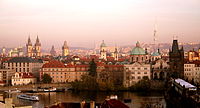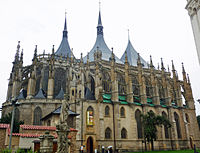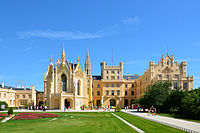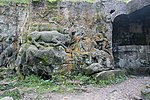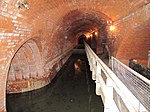World Heritage in the Czech Republic
World Heritage Sites in the Czech Republic |
The World Heritage in the Czech Republic (as of 2019) includes 14 UNESCO World Heritage sites , all of which are world cultural heritage sites. The Czech Republic joined the World Heritage Convention in 1993, and the first three World Heritage sites were added to the World Heritage List in 1992. The last World Heritage Sites to date were registered in 2019.
World heritage sites
The following table lists the UNESCO World Heritage Sites in the Czech Republic in chronological order according to the year of their inclusion in the World Heritage List (K - cultural heritage, N - natural heritage, K / N - mixed, (R) - on the Red List of World Heritage in Danger ).
![]() Map with all coordinates of World Heritage Sites: OSM
Map with all coordinates of World Heritage Sites: OSM
| image | designation | year | Type | Ref. | description |
|---|---|---|---|---|---|
| Historic Center of Praha (Prague) | 1992 | K | 616 | The area roughly comprises the formerly legally independent cities of Staré Město (Old Town), Nové Město (New Town), Malá Strana (Lesser Town) and Hradčany, which were merged into one town in 1784, including the two castle complexes Vyšehrad in the south and Prague Castle in the north, one of the largest castle complexes the world, as well as the Jewish quarter Josefov (Josefstadt) enclosed by the Staré Město (old town ). In 2010 the Průhonice Castle Park was added. | |
| Historical center of Český Krumlov (Bohemian Krumlov) | 1992 | K | 617 | The medieval town center of Český Krumlov (Bohemian Krumlov), located in a loop of the Vltava, with its extensive castle and palace complex, is a unique example of medieval town development. The castle and chateau are primarily characterized by their extensive grounds; it is the second largest castle complex in the Czech Republic after the Prague Castle. Further to the west is the riding school and a park in the late Baroque style with a cascading fountain from the mid-18th century and the Bellaria summer residence. | |
| Historical center of Telč | 1992 | K | 621 | The historic city center and the old town of Telč are one of the most valuable urban monument reserves in Moravia. The dominant and most important monument of the city is the castle in Renaissance style, which connects directly to the city center. The old town, whose historical part is arranged around the Church of Our Lady (Kostel Matky Boží), is also part of the world heritage. | |
|
Pilgrimage Church of St. John Nepomuk by Zelena Hora (Grüneberg) ( location ) |
1994 | K | 690 | The pilgrimage church of St. John of Nepomuk is one of the most important buildings designed by the Baroque architect Johann Blasius Santini-Aichel . The church was built in the Baroque Gothic style in the years 1719–1722 on the Zelená Hora near Saar ( Žďár nad Sázavou ). | |
| Historic center of Kutná Hora and St. Mary's Church in Sedlec | 1995 | K | 732 | Silver was mined in the old royal town of Kutná Hora , a treasury of the Bohemian kings. The historic old town of Kutná Hora with the late Gothic Church of St. Barbara and the Church of the Assumption and St. John the Baptist of the Sedlec Monastery are part of the world heritage . The historic old town of Kutná Hora includes the Italian courtyard, the stone house, the Church of St. James, the Jesuit college and the monastery of St. Ursula. | |
| Cultural landscape of Lednice (Eisgrub) -Valtice (Feldsberg) | 1996 | K | 763 | The Lednice-Valtice Cultural Landscape is a landscape complex with an area of 283 square kilometers in the Okres Břeclav . This area on the border between Moravia and Lower Austria was converted into a nature park by the Princes of Liechtenstein in the 18th and 19th centuries . In the villages of Valtice and Lednice , which are connected by the Bezruč avenue from 1715, and the village of Hlohovec , important landscape features have been artificially created, e.g. B. Boří les and Lednice fish ponds. The area also includes parts of the alluvial forest on the Thaya south of Břeclav . There are also aqueducts and remains of the former irrigation system for the castle park. | |
| Kroměříž Castle and Park | 1998 | K | 860 | The early baroque archiepiscopal palace , the adjoining palace park and the flower garden are the most important cultural monuments of Kroměříž . | |
|
Historic village Holašovice (Hollschowitz) ( location ) |
1998 | K | 861 | The village monument reserve in Holašovice is a medieval system of residential buildings in the so-called peasant baroque style , with a stucco decoration. The reserve consists of 23 individual farmsteads with a total of 120 buildings and wells with wooden piston pumps and courtyard no.6, which has been the seat of a farming family since 1530. | |
|
Lytomyšl Castle (Leitomischl) ( location ) |
1999 | K | 901 | In Litomyšl , the Renaissance chateau and chateau area from the second half of the 16th century are registered as world heritage. This includes the outbuildings and the palace garden. The interior of the castle was changed in the 18th century, but the Renaissance sgraffito facades were retained. | |
| Trinity Column in Olomouc (Olomouc) | 2000 | K | 859 | The Trinity Column in Olomouc (also called Plague Column) was built between 1716 and 1754. It served the Catholic Church for worship and to strengthen the faith. The column was erected out of gratitude for the end of the plague that ravaged Moravia between 1714 and 1716. All the artists and craftsmen who worked on the column were citizens of Olomouc. The approximately 35 m high column represents the highest sculptural cultural monument in the Czech Republic and has a small chapel. | |
|
House Tugendhat in Brno ( location ) |
2001 | K | The Villa Tugendhat in Brno is the most famous villa by the architect Mies van der Rohe , it was built between 1929 and 1930. The villa has 3 levels, the main floor with entrance area, study and dining room, the basement with laundry room, storage rooms, darkroom and boiler room and the upper floor with bedroom, children's room and maids room. The garden is designed as part of the building. The villa was used for other purposes during the Second World War and afterwards until the 1980s, but has now been reconstructed and made accessible. | ||
| Jewish Quarter and Basilica of St. Prokop in Třebíč (Trebitsch) | 2003 | K | 1078 | The Jewish Quarter in Třebíč and the St. Prokop Basilica are part of the World Heritage List. The St. Marien Basilica has a valuable crypt (around 700 years old) with original ceiling paintings. The basilica was used for secular purposes for 200 years, then the interior was redesigned by Kamil Hilbert in 1924–1935 . The Jewish Quarter includes the town hall, schools, poor houses and a synagogue. The old Jewish cemetery is located on the castle hill (Kopec Hrádek), it has around 3000 tombstones and was laid out in 1631. A ceremonial hall has existed in the Jewish cemetery since 1903 and is the only building of its kind outside of Israel that is on the World Heritage List. | |
|
Ore Mountains / Krušnohoří Mining Region ( location ) |
2019 | K | 1478 | Transnational world heritage site together with Germany . The mining region stands for an unusual continuity of mining tradition. In the late Middle Ages it was the main source of silver ore, later tin and finally uranium were mined. From the 12th to the 20th century, the Erzgebirge was the focus of mining innovation, which manifests itself in the water management, the mining towns and the processing sites, which largely remain part of the world heritage.
Five of the 22 components are located on Czech territory: Jáchymov , Red Tower of Death , Abertamy - Bozi Dar - Horní Blatná , Kupferberg and Krupka . Fulfilled criteria for world heritage : intersection of human values (ii), cultural testimony (iii), testimony to a section of human history (iv) |
|
|
Landscape for the breeding and dressage of ceremonial chariot horses in Kladruby nad Labem ( Lage ) |
2019 | K | 1589 | The breeding and dressage landscape of the Kladruber chariot horses at the Habsburg court is in the Elbe lowlands. The facility was founded in 1579 and is still dedicated to its purpose today. It is a testament to the important role horses once played in transport, agriculture and the military.
Fulfilled criteria for World Heritage : testimony to a section of human history (iv), traditional form of settlement, land or sea use (v) |
Tentative list
The sites that are intended for nomination for inclusion in the World Heritage List are entered in the tentative list .
Current World Heritage candidates
As of 2020, 17 sites are entered in the tentative list of the Czech Republic, the last entry was made in 2020. The following table lists the sites in chronological order according to the year of their inclusion in the tentative list.
![]() Map with all coordinates of current World Heritage candidates: OSM
Map with all coordinates of current World Heritage candidates: OSM
| image | designation | year | Type | Ref. | description |
|---|---|---|---|---|---|
|
Renaissance houses in Slavonice ( location ) |
2001 | K | 1507 | Complex of town houses in Slavonice from the late Gothic and Renaissance | |
| Paper mill in Velké Losiny | 2001 | K | 1508 | 16th century paper mill for the production of handmade paper in the municipality of Velké Losiny | |
| Fish pond network in the Třebon basin | 2001 | K | 1509 | ||
| Rock towns of the Český ráj | 2001 | N | 1511 | The Český ráj (German: Bohemian Paradise) is a low mountain range in the northeast of the Czech Republic , on the central reaches of the Jizera , which is characterized by its well-known rock towns made of sandstone . | |
|
Sites of Great Moravia ( location ) |
2001 | K | 1559 | Transnational proposal of sites from Moravia together with Slovakia (Ref. 5093 ), includes the Morava Castle near Mikulčice in the Czech Republic | |
| Industrial plants in Ostrava | 2001 | K | 1560 | ||
|
Terezín Fortress ( location ) |
2001 | K | 1561 | ||
|
Luhačovice Spa ( location ) |
2001 | K | 1562 | Was also part of the Great Spas of Europe proposal (Ref. 5929 ) from 2014-2016 | |
| Rock sculptures by Betlém near Kuks | 2001 | K | 1563 | ||
|
Karlštejn Castle ( location ) |
2001 | K | 1564 | ||
| Expansion of the world cultural heritage of Prague Old Town to include important structures in the area | 2001 | K | 1565 | Planned expansion of the existing World Heritage site (Ref. 616 ) to include Villa Müller , Břevnov Abbey and Hvězda Hunting Lodge | |
|
Mountain hotel and TV station Ještěd ( location ) |
2007 | K | 5152 | ||
| Žatec - the hop city | 2007 | K | 5153 | ||
| West Bohemian spa triangle | 2008 | K | 5378 | includes the three health resorts Karlsbad , Marienbad and Franzensbad . | |
| Important health resorts in Europe | 2014 | K | 5929 | The transnational proposal together with Belgium (Ref. 5932 ), Germany (Ref. 5934 ), France (Ref. 5931 ), Italy (Ref. 5928 ), Austria (Ref. 5930 ) and the United Kingdom (Ref. 5935 ) includes in Czech Republic the three health resorts Karlsbad , Marienbad and Franzensbad .
The proposal included the Luhačovice spa until 2016 (see our own proposal Ref. 1562 ). After its withdrawal, the sites from the Czech Republic contained in the transnational proposal correspond to those of the separate national proposal West Bohemian Spa Triangle (Ref. 5378 ). |
|
| Primeval beech forests and old beech forests of the Carpathians and other regions of Europe (extension) | 2019 | N | 6393 | Extension of the World Heritage Site of Primeval Beech Forests and Old Beech Forests of the Carpathians and other regions of Europe to include the Jizerskohorské bučiny protected area . | |
|
Old sewage treatment plant in Prague-Bubeneč ( location ) |
2020 | K | 6485 |
Former World Heritage candidates
These sites were previously on the tentative list, but were withdrawn or rejected by UNESCO. Sites that are included in other entries on the tentative list or that are part of world heritage sites are not taken into account here.
![]() Map with all coordinates of former World Heritage candidates: OSM
Map with all coordinates of former World Heritage candidates: OSM
| image | designation | year | Type | Ref. | description |
|---|---|---|---|---|---|
|
Monastery church in Kladruby ( location ) |
1993-1994 | K | 691 | Rejected by Unesco in 1994 | |
|
Historic center of Olomouc ( location ) |
1993-2000 | K | In 2000, only the Trinity Column was included in the World Heritage List. | ||
| Timeless and humanistic architecture by Jože Plečnik in Ljubljana and Prague | 2015-2018 | K | 5967 | In the proposal made jointly with Slovenia, the Church of the Lord's Sacred Heart was nominated in Prague . After it became clear that this transnational application had little chance of success, Slovenia decided to pursue the application on its own. |
Web links
- Czech Republic on the UNESCO World Heritage Center website.
Individual evidence
- ↑ Czech Republic. In: whc.unesco.org. UNESCO World Heritage Center, accessed July 11, 2019 .
- ↑ German names according to the World Heritage List. In: www.unesco.de. German UNESCO Commission, accessed on July 11, 2019 .
- ^ Tentative list of the Czech Republic. In: whc.unesco.org. UNESCO World Heritage Center, accessed July 24, 2020 .
- ^ Former Tentative Sites of Czechia. In: World Heritage Site. Retrieved July 28, 2017 (English).
- ↑ Slovenia to proceed with UNESCO listing of Plečnik's works alone. STA (Slovenska tiskovna agencija, national news agency of Slovenia), December 27, 2017, accessed on March 15, 2018 .

